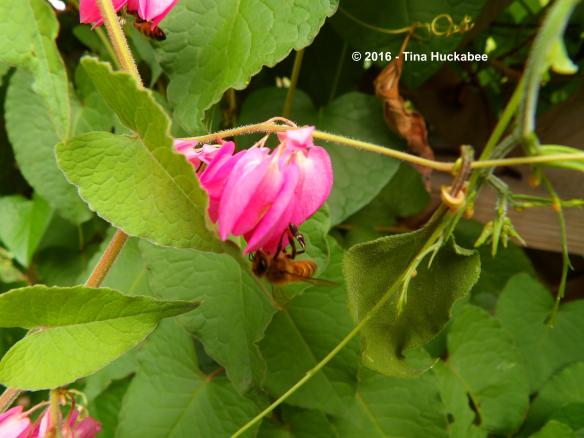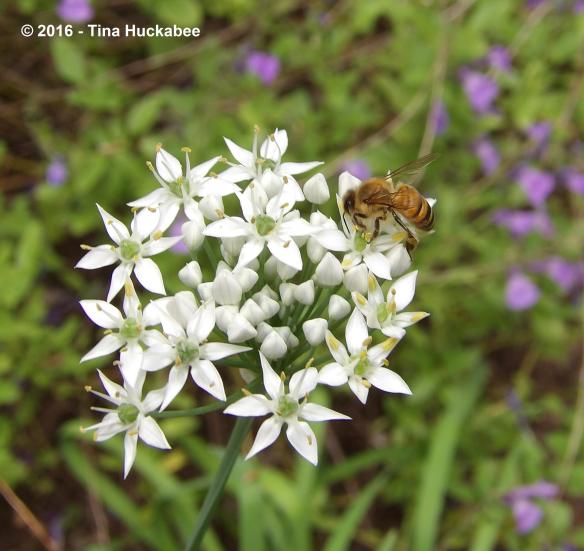I suppose the title should read: Bees in Blooms.
Bees of all stripes and wings are active in the late summer garden, sticking their probosces into the depths of flowers and reveling in pollen. This week, I’m crowning the honeybees as the winners of the bee beauty pageant. From a purely self-interested standpoint, honeybees are significantly easier to photograph, as they’re not speed fliers, nor teeny-tiny, like most of the native bees.
A preferred nectar source for honeybees are the charming blooms of the Coral Vine, Antigonon leptopus.
I grow one small bit of this vine and from late summer into fall, the bees are all over it, all the time. Tagged as an invasive plant here in Texas, as well as some other southern states, in all the years I’ve grown my vine I’ve only seen two or three seedlings develop. That said, I probably wouldn’t grow it if I live in a rural area and not smack-dab in the middle of a city, at some distance from a green belt. Rural gardeners should steer clear of this plant and choose native-to-region plants instead.
Honeybees enjoy the flowerets of Frostweed, Verbesina virginica, a native perennial best known as a migrating Monarch butterfly favorite and a post hard-freeze ice-sculpture plant.
Majestic sage, Salvia guaranitica, is lush with its royal blooms this wetter-than-normal summer. Typically, I see one or two native bee species at this plant, but honeybees have shown interest in stealing nectar.
Zexmenia, Wedelia texensis, always hosts a variety of native pollinators who work its cheery yellow blooms; honeybees are included in that mix.
Garlic chives, Allium tuberosum, recently began their short bloom cycle in my garden, but it didn’t take long for the honeys to find them.
I wonder what garlic honey might taste like? Mmmm!
Another perennial preference of honeybees and many other pollinators is the Rock rose, Pavonia lasiopetala. I like this back-lit shot with the early morning sun, setting bee and bloom aglow.
As well as this shot, which simply highlights both–and the foliage, as well.
An impulse buy from a nursery a couple of years ago as I observed honeybees clamoring for nectar from its blooms, is this Shrubby blue sage, Salvia ballotiflora.
I’d say that the bee is busy and content with its bounty. The Shrubby blue sage also attracts several species of native carpenter bees, as well as a variety of butterflies.
The native-to-South Texas, Yellow bells, Tacoma stans, always has bee visitors, but rarely (or so it seems) at the angle that I can easily photograph. No bees at this bloom cluster, but these flowers always please.
A bee-less photo, but of a great bloomer and nectar source for many different pollinators.
Another bee-less photo is of blooming Garlic chives and in the background, a purple blooming Autumn sage, Salvia greggii.
Both typically have pollinators in attendance; I happened to catch the combo in a quiet moment.
I thank Carol at May Dreams Garden for hosting this monthly bloom bonanza known as Garden Bloggers’ Bloom Day. Join in, share your garden pretties, then click over to her lovely blog to see and learn about blooms from many places.
















I am so enjoying your blog! We live in the country near Blanco and have the love of gardening and beekeeping in common with you. I do admit you have a much more extensive knowledge of bugs than I! Your writing and photography inspires me as I enjoy my gardens and little yellow and black striped honey-makers. Keep up the good work!
LikeLike
Thank you, Tonya!! How nice to be near Blanco–I’ll bet it’s lovely. I’m sure you will enjoy your gardens and your bee-buddies.
LikeLike
Great photos. You garden is looking good. I did not know that about coral vine. I have a scraggly one that climbs to the top of a tree and puts out a few blooms. I do see hummingbirds on it, the bees are too small!
LikeLike
Thanks! Yeah, I didn’t know about the coral vine either until recently. I don’t think of it as being a problem plant, but I could see it being obnoxious in a rural area, especially in a wet year. I’ve never seen hummers visiting my coral–only bees and butterflies and anole lizards trying catch them!
LikeLiked by 1 person
Lovely blooms!
Bees are the jewelry that a flower wears!
Happy Garden Bloggers’ Bloom Day!
LikeLike
Thanks, Lea! I like that–bees as jewels–nice!
LikeLike
Wonderful pollinator photos (and flowers!). And I can see why they like your garden. Happy Bloom Day!
LikeLike
Thanks, Beth. I sure hope their happy, or at least being kept busy.
LikeLike
A lovely selection of flowers and it’s interesting to see what the bees are enjoying in your garden. I planted salvias for my bees and lost them in cold weather, sadly – but I haven’t given up on these flowers yet and will plant some more.
LikeLike
Honeybees will enjoy just about anything that isn’t sterile, so plant away! Good luck in trying your salvia again.
LikeLike
What a great title you found Tina! Great to see them bee-flowers 🙂
LikeLike
The bees do seem happy, don’t they?
LikeLike
I just laughed about the coral vine. I have a friend who lives outside Kerrville who’s been trying to get hers to spread for years, and it refuses to do so. There has to be some limiting factor that she hasn’t figured out, but I’m going to tell her she might count herself lucky and leave things alone.
You’ve reminded me that I found some frostweed flowering last year, before I knew what frostweed flowers were. I need to go back this weekend and see if it’s blooming yet. We seem to be behind central Texas. I still haven’t seen Maximilian sunflowers or blue mistflower, either, and they were thick last year. Perhaps so much rain and heat has slowed them down a bit.
LikeLike
I was surprised too when I learned that it was considered invasive. Mine has never “leaked” out and I’ve never seen birds snatching the seeds and carrying them off. Nonetheless, it seems that it’s considered a no-no plant.
My frostweed has bloomed all summer!! That’s never happened and I’m owing it to the wet summer we’ve had. The bees and butterflies haven’t complained, so I’m on board with that. You’re right though, with all the rain, there’s more foliage growth and some of the blooms are behind, especially native blooms.
LikeLike
I just got back from a day at Armand Bayou Nature Center, and the frostweed was everywhere. Also, I asked a couple of staff members about the Maximilians, etc., and they said that the rain has put everything behind. Not only that, they aren’t certain that the sunflowers, liatris, and such, will be so prolific this year because of the rain. It seems counter-intuitive to me, but of course there are plants that prefer it a little (or lot!) more dry than we’ve had it this year.
LikeLike
I never like a wet year–most of the plants I grow like it on the dry side, so a moderate drought is just perfect. Many of my perennials–while doing okay– would probably be better off if the year hadn’t been so wet.
LikeLike
Tina preciosas fotos de las abejas trabajando en preciosas flores. Me encantan las abejas. Qué trabajadoras son y como nos hacen falta a los humanos para fertilizar nuestros cultivos y por supuesto nuestras flores. La Vid coralina tiene unas flores preciosas y siento mucho que la tengan por una planta invasiva. La foto que más me gusta es la flor de la planta Rock rose con una abeja comiendo: es una maravilla. Saludos de Margarita.
LikeLike
I love bees too, Margarita, and am so glad the ones in my garden are healthy.
LikeLike
Sí se las ve muy activas y guapas en las fotos. Son unas abejas con mucha salud igual que sus plantas. Porque comen de plantas sanas son unas chicas y unos chicos sanos y fuertes. En serio se les ve a todos muy saludables. ¿Cómo están sus colmenas?
LikeLike
The hives are doing fine; I checked them last week and they’re still strong as we go into fall!
LikeLike
Great bee and flower pictures! You’ve got a great diversity. They can be difficult to photograph, especially the littler ones, can’t they?
LikeLike
The tiny native bees are really tough to capture in photos–everything has to be JUST RIGHT for a good shot.
LikeLiked by 1 person